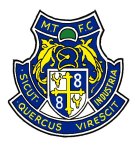Mansfield Mechanics FC was founded in 1901 and played at the Stanhope Street Ground, a venue which was developed into an enclosed ground. The Mechanics moved to Westfield Lane in 1911, later to become known as the Chesterfield Road Recreation Ground and still in use for minor football today. In 1912 Mechanics moved to Field Mill where they remained until the First World War. After the War, Mechanics considered a merger with a branch of the local Wesleyan Boy’s Brigade, playing under the name Mansfield Wesleyans from 1897. (Weslyans followed their own "religion") In 1905, this club turned professional and the churchmen insisted that the side changed their name to Mansfield Wesley.
After the club had entered the Notts & District League, the name was changed again, this time to Mansfield Town, in 1910. Mansfield Mechanics complained to the FA about this as they considered themselves as the premier team in the town, but the name change stood.
Mansfield Town moved to a larger open area in 1914, south of Ratcliffe Gate, which, due to its wide open space, gloried in the name of The Prairie. A postwar amalgamation between Mechanics and Mansfield Town would have made a lot of sense, the former having Field Mill as a venue, the latter superior playing resources and a very enthusiastic support. While the talks were going on, Mansfield Town were secretly negotiating with the owner of Field Mill, the Duke of Portland, to go it alone as the exclusive tenants of Field Mill. Thus snubbed, the Mechanics continued to play as a separate team until folding in 1923, by which time Mansfield Town had become a member of the Midland League.
Football in Mansfield has had a long and colourful history, but perhaps not as colourful as their kits through the years. Mansfield Weslyans wore chocolate and light blue stripes with navy blue short. In 1905/6, the stripes were replaced by halves. In 1910 the name change brought a colour change too as red shirts and white shorts were adopted. A season later however black and white quarters were worn, and this kit stayed until the First World War. After the war, the club adopted the now familiar amber and blue. Initially wearing amber and blue halves with white shorts. On acceptance into the Football League in 1931 however the team were wearing light blue shirts and white shorts.
Over the years the club then tried a myriad of colours, often focussed around the amber and blue. Quarters and halves were worn until past the Second World War, and in the early Fifties the team wore blue shirts with amber sleeves.
For a period until 1961, the team colours were white shirts with black shorts, but since then amber and blue have dominated: amber shirts with blue trim, blue shirts with amber trim, and a classically simple white with blue and amber trim have all appeared at Field Mill. The colours are distinctive, but the design is an ever-changing kaleidoscope. Mansfield Town have been nicknamed the Stags since the 1920s, after the small deer species, often found in the Sherwood Forest nearby.
The club’s badge has had a single-minded theme since the 1960s, encompassing this same stag. Before that, Mansfield Town’s emblem was the coat of arms of the old Borough of Mansfield. Incidentally, this emblem never appeared on the club shirts.

In the shield there is the cross moline of the Bentinck family, differenced by having a fleur de lis termination to each end in gold (working that out??). This cross moline separates the four divisions of the shield, while the stag’s heads from the arms of the Cavendish-Bentinck family on a ground sable occur in the first and fourth quarterings. The second and third quarterings are occupied by hanks of cotton, referring to the trade (industry) of Mansfield. The crest, which is given in the small circle at the top of the badge is the famous Parliament Oak, represented in its full vigour. Beside this are the two stars of Murray, the Earl of Mansfield and in front of it are the two cross crosslets from the Howard family.
At Field Mill, the stadium, listen out for the loyal supporters mumbling a Latin phrase during the course of the game. It’s probably the motto of the old emblem “Siqut quercus virescit industria “, meaning “Industry flourishes as the oak”. Really??!! Unlikely these days....




No comments:
Post a Comment